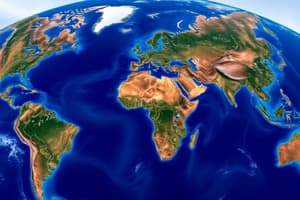Podcast
Questions and Answers
Which unit of time on the geological time scale encompasses a period of millions of years?
Which unit of time on the geological time scale encompasses a period of millions of years?
- Era
- Epoch (correct)
- Period
- Eon
What is the geological time category that does not consist of a uniform length of time?
What is the geological time category that does not consist of a uniform length of time?
- Period
- Eon
- Era (correct)
- Epoch
Which era is characterized as the age of mammals?
Which era is characterized as the age of mammals?
- Paleozoic Era
- Mesozoic Era
- Cenozoic Era (correct)
- Precambrian Era
What is the geological time scale unit that is the largest period of geological time?
What is the geological time scale unit that is the largest period of geological time?
Which era is the age of reptiles?
Which era is the age of reptiles?
What are the two major groups of geologic processes?
What are the two major groups of geologic processes?
Which observation of Wegener's theory is based on the match of mountain belts and rock types?
Which observation of Wegener's theory is based on the match of mountain belts and rock types?
What type of processes result in the building of plateaus, rift valleys, and volcanic mountains?
What type of processes result in the building of plateaus, rift valleys, and volcanic mountains?
Which observation did Wegener make based on the distribution of plant and animal fossils?
Which observation did Wegener make based on the distribution of plant and animal fossils?
What was the major geologic event of the Precambrian Era?
What was the major geologic event of the Precambrian Era?
What did Wegener's observations of paleoclimates provide evidence for?
What did Wegener's observations of paleoclimates provide evidence for?
What process contributed to reducing the mountains to near-level rock surfaces?
What process contributed to reducing the mountains to near-level rock surfaces?
What types of rocks are the Precambrian rocks altered into due to pressure, heat, and earth movements?
What types of rocks are the Precambrian rocks altered into due to pressure, heat, and earth movements?
What sits beneath most rocks in Ethiopia, forming the basement rocks?
What sits beneath most rocks in Ethiopia, forming the basement rocks?
What overlays the Precambrian rocks?
What overlays the Precambrian rocks?
What covers the 'levelled' surface formed after the last orogenesis in the Precambrian Era?
What covers the 'levelled' surface formed after the last orogenesis in the Precambrian Era?
During which geological era were the sediments in Ethiopia transported southward and eastward to form continental and marine deposits?
During which geological era were the sediments in Ethiopia transported southward and eastward to form continental and marine deposits?
In which part of Ethiopia do we find the Adigrat sandstone and Hintalo limestone layers?
In which part of Ethiopia do we find the Adigrat sandstone and Hintalo limestone layers?
What was the major geological process of the Paleozoic Era?
What was the major geological process of the Paleozoic Era?
During which era did the land in present-day Horn of Africa and Arabian landmass experience alternate slow sinking and rising?
During which era did the land in present-day Horn of Africa and Arabian landmass experience alternate slow sinking and rising?
Which geological era is considered to have the greatest potential for oil and gas deposits?
Which geological era is considered to have the greatest potential for oil and gas deposits?
Which major geological event led to the formation of the Adigrat sandstone and Hintalo limestone layers?
Which major geological event led to the formation of the Adigrat sandstone and Hintalo limestone layers?
What type of rock surface was formed as a result of denudation during the Paleozoic Era?
What type of rock surface was formed as a result of denudation during the Paleozoic Era?
In which region of Ethiopia were rocks belonging to the Paleozoic Era found to be rare?
In which region of Ethiopia were rocks belonging to the Paleozoic Era found to be rare?
During which era were the sediments transported to form marine deposits?
During which era were the sediments transported to form marine deposits?
Which geological era experienced compression by overlying rocks and cementing minerals resulting in sandstone and limestone layers?
Which geological era experienced compression by overlying rocks and cementing minerals resulting in sandstone and limestone layers?
Flashcards are hidden until you start studying
Study Notes
Geological Time Scale Units
- Geological time scale units include eons, eras, periods, epochs, and ages, with eras being substantial periods often spanning millions of years.
- Geological categories do not consist of uniform lengths; for example, an era can vary widely in duration.
Major Geological Eras
- The Cenozoic Era is known as the age of mammals, marked by significant mammalian diversification.
- The Mesozoic Era is characterized as the age of reptiles, including the dominance of dinosaurs.
- The largest period of geological time is an eon, with the Phanerozoic being the most recent, encompassing three eras.
Geologic Processes
- Two major groups of geologic processes are endogenic (internal) processes and exogenic (external) processes.
- Tectonic and volcanic processes contribute to the formation of plateaus, rift valleys, and volcanic mountains.
Alfred Wegener's Theory
- Wegener's observations included the alignment of mountain belts and rock types as evidence for continental drift.
- He noted the distribution of similar plant and animal fossils across different continents, supporting his theory of continental continuity.
- Paleoclimate observations provided evidence that continents were once connected in different climatic zones.
Precambrian Era
- The Precambrian Era saw significant geological activity, including the formation of the Earth’s crust.
- Major geological events during this era involved the leveling of mountains, resulting from erosion processes.
- Precambrian rocks can metamorphose into different rock types due to pressure and heat, typically resulting in schist and gneiss.
Ethiopian Geology
- Most rocks in Ethiopia are underlain by ancient basement rocks formed from Precambrian deposits.
- Precambrian rocks are overlain by younger sedimentary rocks, which include various formations.
- After the last orogenesis, a 'levelled' surface formed, later covered by sediments from subsequent geological activity.
Sedimentary Processes
- During the Mesozoic Era, sediments were transported southward and eastward in present-day Horn of Africa, leading to continental and marine deposits.
- The Adigrat sandstone and Hintalo limestone layers are found primarily in the northern regions of Ethiopia.
- The Paleozoic Era experienced significant geological processes, including sedimentation leading to marine deposits.
Oil and Gas Potential
- The Mesozoic Era is regarded as having the highest potential for oil and gas deposits, due to extensive sedimentation and organic material accumulation.
- Compression resulting from overlying rocks created sandstone and limestone layers during the Paleozoic Era.
Regional Geological Characteristics
- Paleozoic Era rocks are comparatively rare in certain Ethiopian regions, indicating less sedimentation.
- The transport of sediments to form marine deposits occurred prominently during specific epochs of the Paleozoic Era.
Studying That Suits You
Use AI to generate personalized quizzes and flashcards to suit your learning preferences.





